Enhancing Fun through Gamification to Improve Engagement in MOOC
Abstract
:1. Introduction
2. Background
2.1. Towards a Hybrid MOOC
2.2. Virtual Learning Communities
2.3. Gamification Principles
2.4. Gamification and VLC
- Progress bar, associated with the additional functionality of the groups, “Units”, which serve to organize the collection and ordering of group publications, managing the chaos that often occurs with so much published information. Members of group are able to mark the publications of each unit seen, checking in the bar its level of progress.
- Digital badges that Facebook itself automatically associates according to the degree or type of participation of members in the group. These, when obtained, are associated with the name of the member who has obtained it, appearing in all the publications made within group. Facebook Groups currently offers 10 different badges [28].
- Different degrees of “likes” (I like it, I love it, it saddens me, etc.), comments and reshares. Although these options are not specific to groups, they are interesting as gamification elements.
3. Materials and Methods
3.1. MOOC
3.2. Virtual Learning Community (Facebook Group)
3.3. Applied Gamification
3.3.1. MOOC and VLC gamification
- Asynchronous activities: A total of 12 exercises distributed within the lessons, in which the student can put into practice what he has learned in the lesson at his own pace, and which encourage him to share the result in the form of a publication in the virtual learning community, thus seeking a flow of content from the MOOC to the VLC [8,31]. They were proposed activities such as creating a profile in the social networks explained and sharing it in the VLC, or looking for additional information about the contents, also sharing it.
- Synchronous activities: 4 interactive live activities were proposed, in form of a broadcast via YouTube video platform, using “Hangouts on-air” [32] live videoconferencing option. Any student with the link could view the live event and participate in the chat on the right side of the video.
- “Building digital identity”: In this event, the professor proposed a collaborative analysis of what actions are carried out on the Internet that leave their mark on the digital identity of any person. We used the chat of the YouTube retransmission through which to participate live; the professor was working on the ideas he was reading written in the chat.
- “What about us on Internet”: In this case was made use of the Kahoot! platform of questions, which allows to use it to apply gamification, given its format of a contest. It was used live, allowing anyone to participate who entered the platform, via web or mobile app, and wrote the specific code provided during the live event for the space created. Through a survey, the activity proposed to participants to make different Internet searches about their name and surname, and to see what information appeared from them, analyzing the results the teacher and contributing ideas.
- “Interview with...”: The last two events had the same configuration, they were two interviews, one per week, to experts in the subject of each week module. The event was designed for maximum participation and protagonism of the students. Four days before the event, a link was sent to a space in the Sli.do questions and answers platform, where any MOOC student could write a question on his or her behalf or anonymously, leaving the question published for anyone to see and vote for. The most voted questions were those that were asked to each one of the interviewees.
3.3.2. Gamified Model
3.4. Data Collection
- MiriadaX allows you to know the number of students enrolled, how many have started and how many have finished.
- Facebook Group offers very detailed statistics, showing information such as active members in the group, number of publications detailed by date, or visits and reactions to publications.
- YouTube allows to know in a very complete way the visualizations of the videos and of the live broadcasts.
- Sli.do and Kahoot! also provide statistics of participation, although they are very basic, for the purpose of the experience have been enough.
4. Results
4.1. Live Events
4.2. Participation in the VLC
4.3. Satisfaction Survey
5. Discussion and Conclusions
Author Contributions
Funding
Acknowledgments
Conflicts of Interest
References
- Stracke, C.M. The Quality of MOOCs: How to improve the design of open education and online courses for learners? In Proceedings of the 4th International Conference on Learning and Collaboration Technologies, Vancouver, BC, Canada, 9–14 July 2017; Springer: Cham, Switzerland, 2017; pp. 285–293. [Google Scholar]
- Siemens, G. Connectivism: A learning theory for the digital age. Int. J. Instr. Technol. Dis. Learn. 2005, 2, 1–8. [Google Scholar]
- Martinez, S. OCW (OpenCourseWare) and MOOC (open course Where?). In Proceedings of the OpenCourseWare Consortium Global, Ljubljana, Slovenia, 23–25 April 2014. [Google Scholar]
- Siemens, G. Massive Open Online Courses: Innovation in Education? Available online: https://oerknowledgecloud.org/sites/oerknowledgecloud.org/files/pub_PS_OER-IRP_CH1.pdf (accessed on 2 July 2019).
- Sein-Echaluce, M.L.; Fidalgo-Blanco, Á.; García-Peñalvo, F.J. Adaptive and cooperative model of knowledge management in MOOCs. In Proceedings of the 4th International Conference on Learning and Collaboration Technologies, Vancouver, BC, Canada, 9–14 July 2017; Springer: Cham, Switzerland, 2017; pp. 273–284. [Google Scholar]
- Leony, D.; Merino, P.J.M.; Valiente, J.A.R.; Pardo, A.; Kloos, C.D. Detection and Evaluation of Emotions in Massive Open Online Courses. J. UCS 2015, 21, 638–655. [Google Scholar]
- Fidalgo-Blanco, Á.; Sein-Echaluce, M.L.; García-Peñalvo, F.J. From massive access to cooperation: Lessons learned and proven results of a hybrid xMOOC/cMOOC pedagogical approach to MOOCs. Int. J. Educ. Technol. High. Educ. 2016, 13, 24. [Google Scholar] [CrossRef]
- Borrás-Gené, O. Empowering MOOC Participants: Dynamic Content Adaptation Through External Tools. In Proceedings of the European MOOCs Stakeholders Summit 2019, Naples, Italy, 20–22 May 2019; Springer: Cham, Switzerland, 2019; pp. 121–130. [Google Scholar]
- Groh, F. Gamification: State of the Art Definition and Utilization. Available online: http://hubscher.org/roland/courses/hf765/readings/Groh_2012.pdf (accessed on 2 July 2019).
- Pelet, J.E.; Pratt, M.A.; Fauvy, S. MOOCs and the integration of social media and curation tools in e-learning. In Proceedings of the International Workshop on Learning Technology for Education in Cloud, Maribor, Slovenia, 24–28 August 2015; Springer: Cham, Switzerland, 2015; pp. 43–53. [Google Scholar]
- Daniel, J.; Cano, E.V.; Cervera, M.G. The future of MOOCs: Adaptive learning or business model? Int. J. Educ. Technol. High. Educ. 2015, 12, 64–73. [Google Scholar] [CrossRef]
- Rodriguez, O. The concept of openness behind c and x-MOOCs (Massive Open Online Courses). Open Praxis. 2013, 5, 67–73. [Google Scholar] [CrossRef]
- Ramírez-Donoso, L.; Pérez-Sanagustín, M.; Neyem, A.; Rojas-Riethmuller, J.S. Promoviendo la colaboración efectiva en MOOCs a través de aplicaciones móviles. In Proceedings of the 2015 CHILEAN Conference on Electrical, Electronics Engineering, Information and Communication Technologies, Santiago, Chile, 28–30 October 2015. [Google Scholar]
- Goldie, J.G.S. Connectivism: A knowledge learning theory for the digital age? Med. Teach. 2016, 38, 1064–1069. [Google Scholar] [CrossRef] [PubMed] [Green Version]
- Núñez-Martinez, M.; Borrás-Gené, O.; Fidalgo-Blanco, Á. Social community in MOOCs: Practical implications and outcomes. In Proceedings of the Second International Conference on Technological Ecosystems for Enhancing Multiculturality (TEEM), Salamanca, Spain, 1–3 October 2014; pp. 147–154. [Google Scholar]
- García, M.I.; Díaz, C.G. Facebook como herramienta educativa en el contexto universitario. Historia y Comunicación Social. 2014, 19, 379–391. [Google Scholar]
- Deterding, S.; Sicart, M.; Nacke, L.; O’Hara, K.; Dixon, D. Gamification. Using game-design elements in non-gaming contexts. In Proceedings of the CHI’11 Extended Abstracts on Human Factors in Computing Systems, Vancouver, BC, Canada, 7–12 May 2011; ACM: New York, NY, USA, 2011; pp. 2425–2428. [Google Scholar]
- Werbach, K.; Hunter, D. The Gamification Toolkit: Dynamics, Mechanics, and Components for the Win; Wharton Digital Press: Philadelphia, PA, USA, 2015. [Google Scholar]
- Kapp, K.M. The Gamification of Learning and Instruction; Wiley: San Francisco, CA, USA, 2013. [Google Scholar]
- Vaibhav, A.; Gupta, P. Gamification of MOOCs for increasing user engagement. In Proceedings of the 2014 IEEE International Conference on MOOC, Innovation and Technology in Education (MITE), Patiala, India, 19–20 December 2014; pp. 290–295. [Google Scholar]
- Borrás-Gené, O.; Martínez-Núñez, M.; Fidalgo-Blanco, Á. New challenges for the motivation and learning in engineering education using gamification in MOOC. Int. J. Eng. Educ. 2016, 32, 501–512. [Google Scholar]
- Klemke, R.; Eradze, M.; Antonaci, A. The flipped MOOC: Using gamification and learning analytics in MOOC design—A conceptual approach. Educ. Sci. 2018, 8, 25. [Google Scholar] [CrossRef]
- Huang, W.H.Y.; Soman, D. Gamification of Education. Available online: https://inside.rotman.utoronto.ca/behaviouraleconomicsinaction/files/2013/09/GuideGamificationEducationDec2013.pdf (accessed on 2 July 2019).
- Kiryakova, G.; Angelova, N.; Yordanova, L. Gamification in education. In Proceedings of the 9th International Balkan Education and Science Conference, Edirne, Turkey, 16–18 October 2014. [Google Scholar]
- Wang, L.; Hu, G.; Zhou, T. Semantic analysis of learners’ emotional tendencies on online MOOC education. Sustainability 2018, 10, 1921. [Google Scholar] [CrossRef]
- Hansch, A.; Newman, C.; Schildhauer, T. Fostering Engagement with Gamification: Review of Current Practices on Online Learning Platforms. Available online: https://papers.ssrn.com/sol3/papers.cfm?abstract_id=2694736 (accessed on 2 July 2019).
- De-Marcos, L.; Domínguez, A.; Saenz-de-Navarrete, J.; Pagés, C. An empirical study comparing gamification and social networking on e-learning. Comput. Educ. 2014, 75, 82–91. [Google Scholar] [CrossRef]
- Discover New Badges to Recognize Admins and Outstanding Members. Available online: https://www.facebook.com/community/education/blog/badges/ (accessed on 4 June 2019).
- Telefónica Premia la Innovación Educativa de los MOOCs a Través de Míriadax. Available online: https://comunicacionmarketing.es/actualidad/24/01/2019/telefonica-premia-la-innovacion-educativa-de-los-moocs-a-traves-de-miriadax/5389.html (accessed on 4 June 2019).
- ¡Conoce los Objetivos de Desarrollo Sostenible a Través del Nuevo MOOC de Miríadax! Available online: https://blogthinkbig.com/desarrollo-sostenible-miriadax (accessed on 27 June 2019).
- García-Peñalvo, F.J.; Cruz-Benito, J.; Borrás-Gené, O.; Blanco, Á.F. Evolution of the Conversation and Knowledge Acquisition in Social Networks Related to a MOOC Course. In Learning and Collaboration Technologies; Zaphiris, P., Ioannou, A., Eds.; Springer: Berlin, German, 2015. [Google Scholar]
- Pérez, A.B.; Borrás-Gené, O. Uso de Hangouts como recurso educativo en abierto en MOOC. In Proceedings of the IV Congreso Internacional sobre Aprendizaje, Innovación y Competitividad (CINAIC), Zaragoza, Spain, 4–6 October 2017. [Google Scholar]
- Marsh, H.W. SEEQ: A Reliable, Valid, and Useful Instrument for Collecting Students’ evaluations of University Teaching. Br. J. Educ. Psychol. 1982, 52, 77–95. [Google Scholar] [CrossRef]
- Schroer, W. Defining, Managing, and Marketing to Generations, X, Y, and Z. IAM 2008, 10, 9. [Google Scholar]
- Högberg, J.; Hamari, J.; Wästlund, E. Gameful Experience Questionnaire (GAMEFULQUEST): An instrument for measuring the perceived gamefulness of system use. User Model. User-Adapt. Interac. 2019, 3, 1–42. [Google Scholar] [CrossRef]
- Dicheva, D.; Dichev, C.; Agre, G.; Angelova, G. Gamification in education: A systematic mapping study. Educ. Technol. Soc. 2015, 18, 75–88. [Google Scholar]
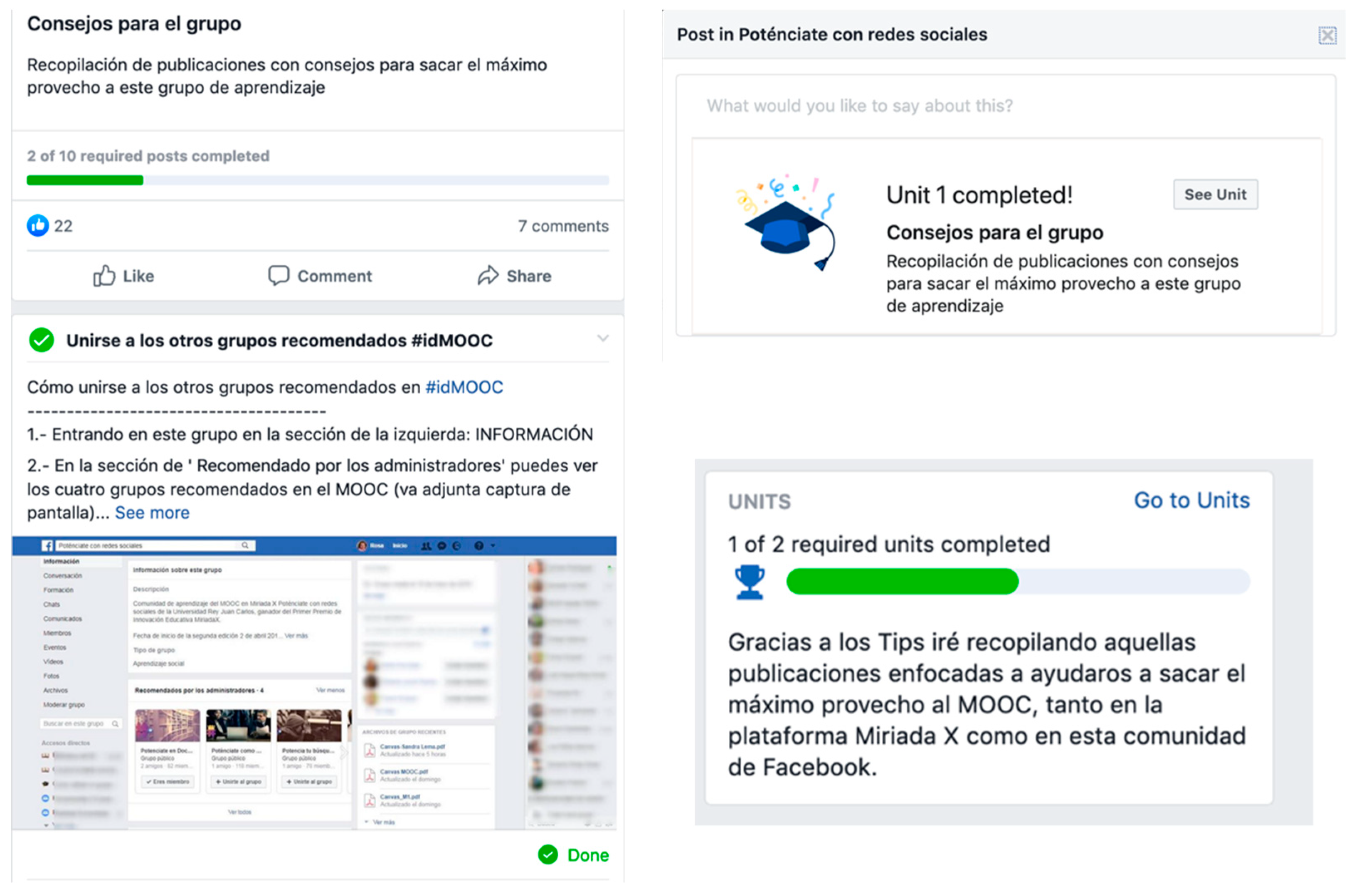
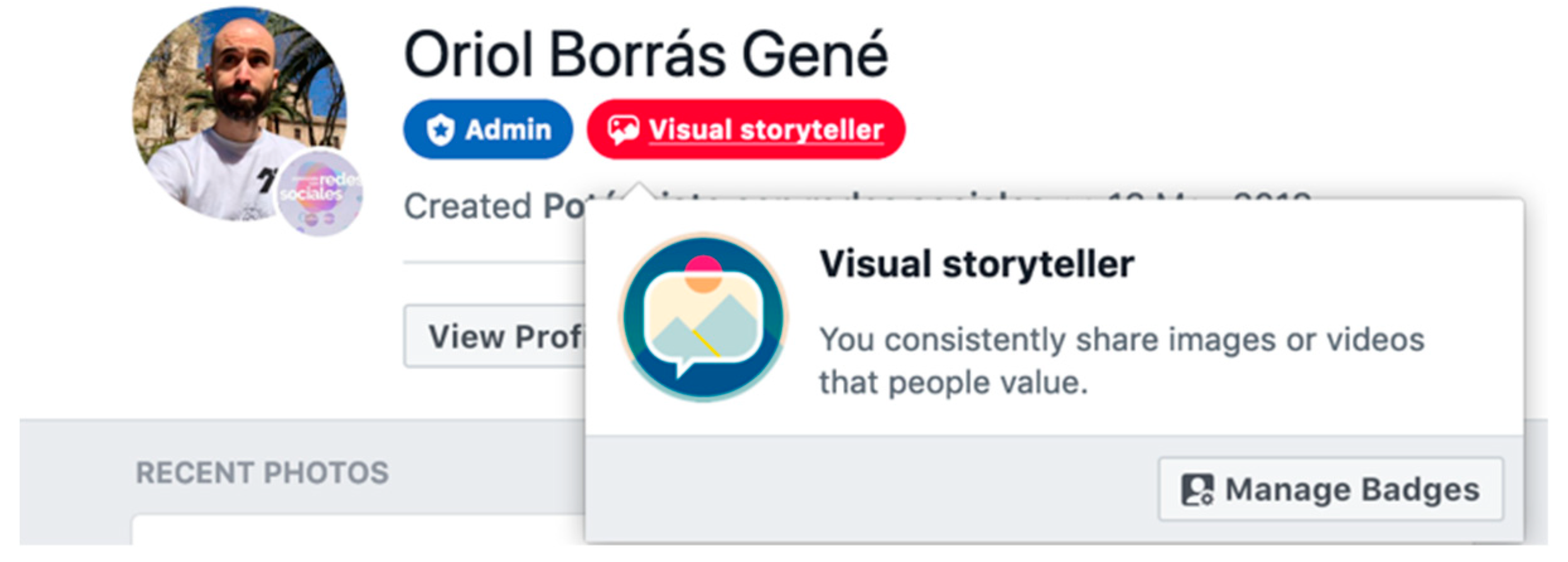
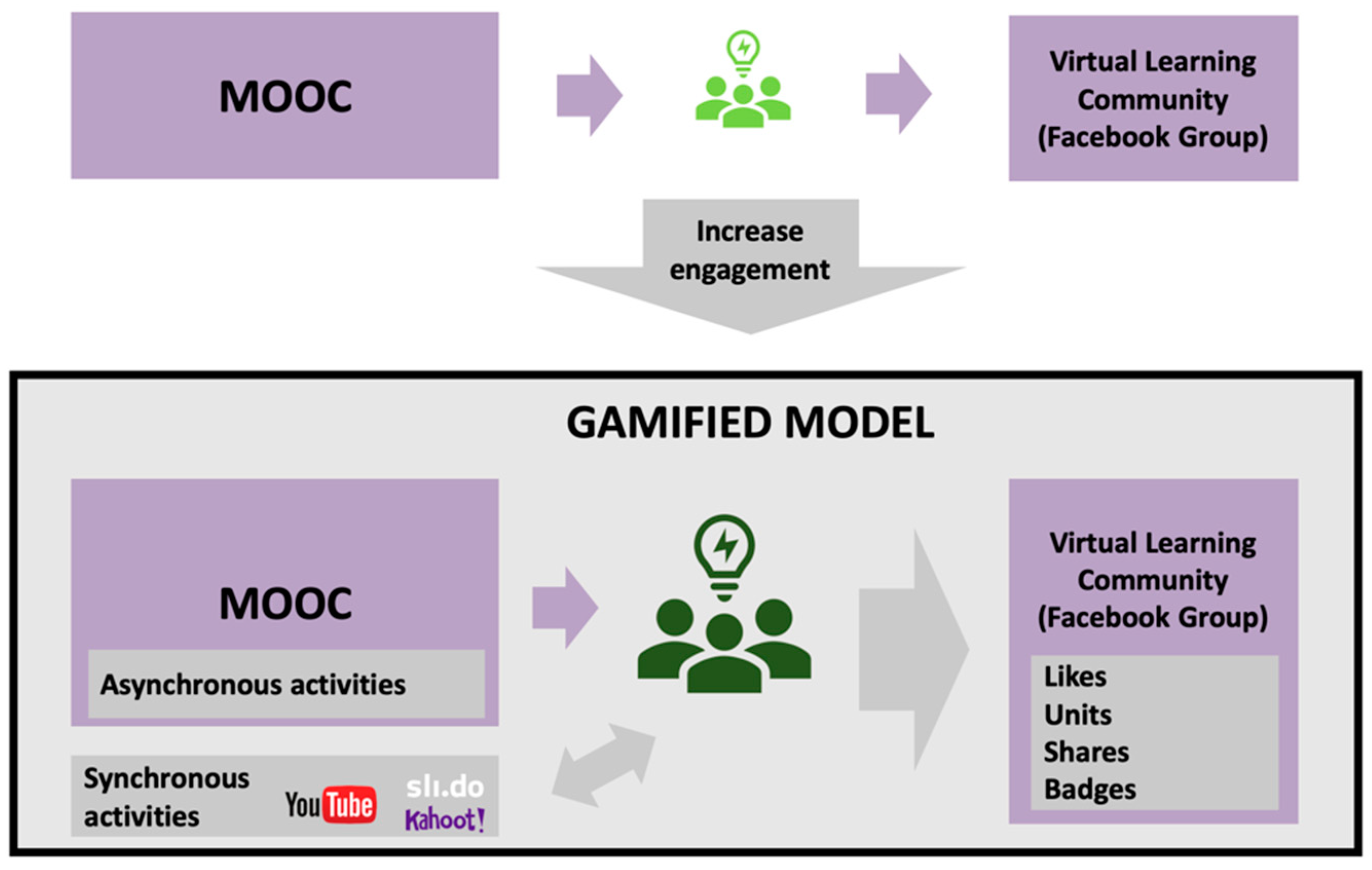
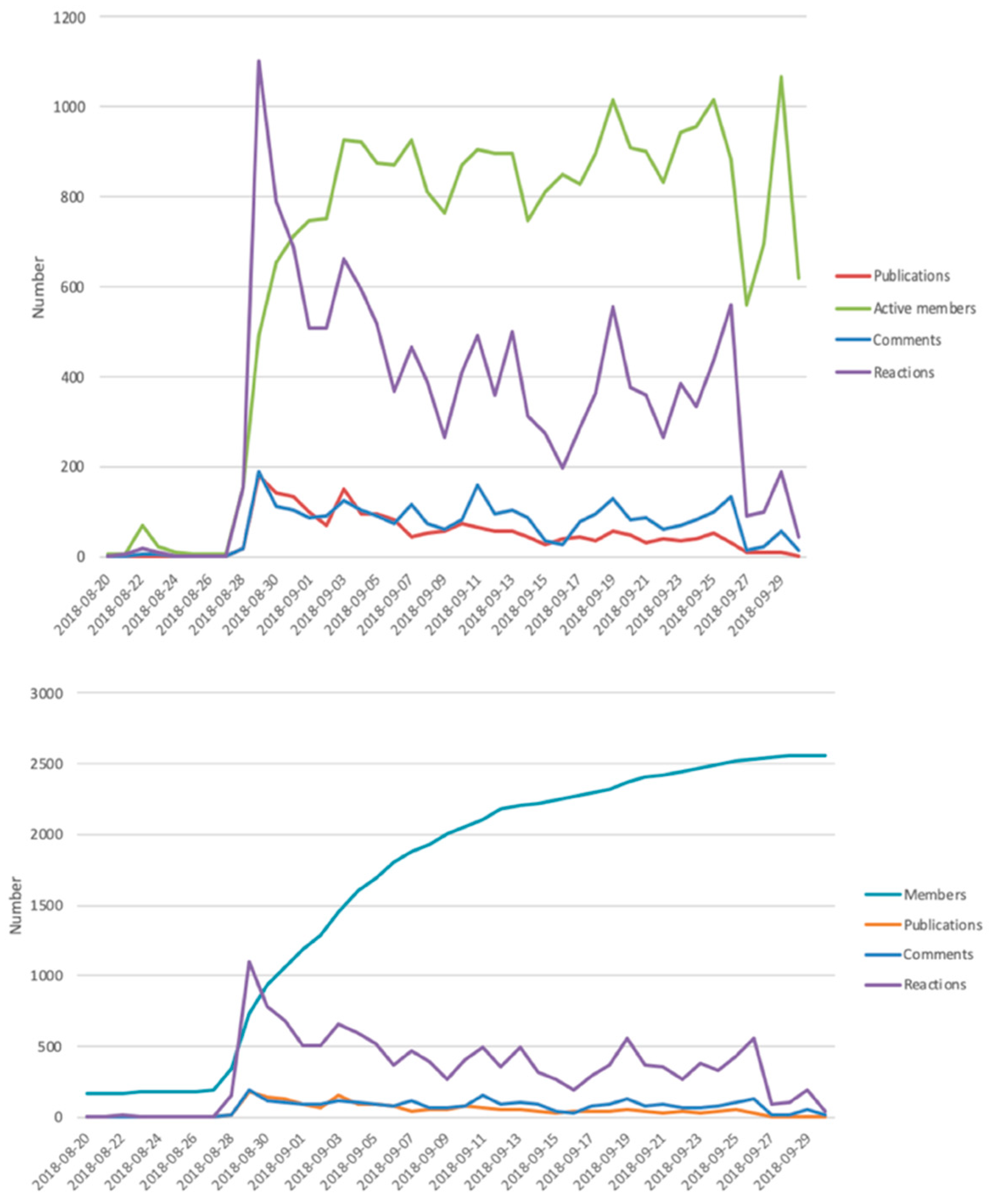
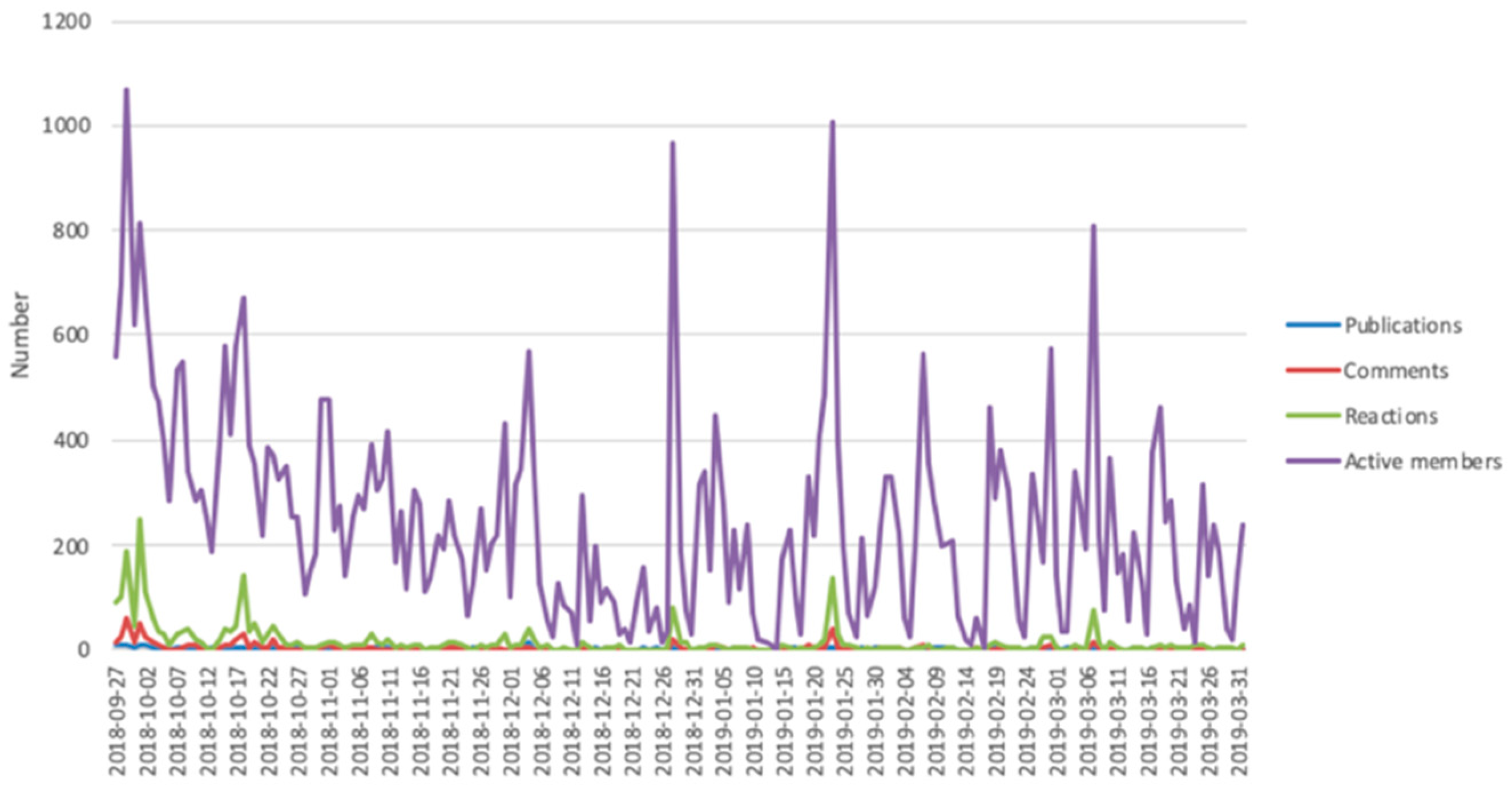
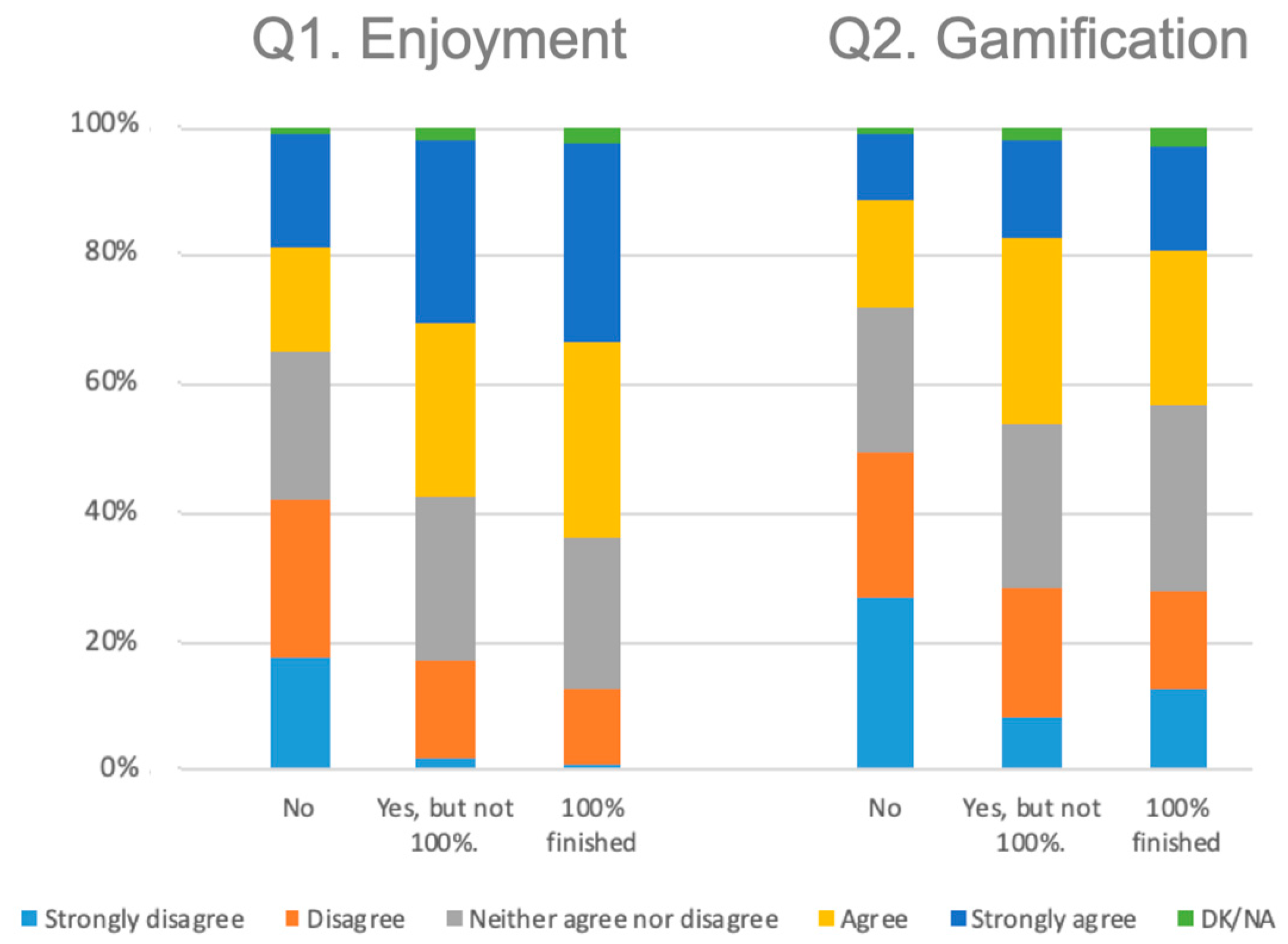
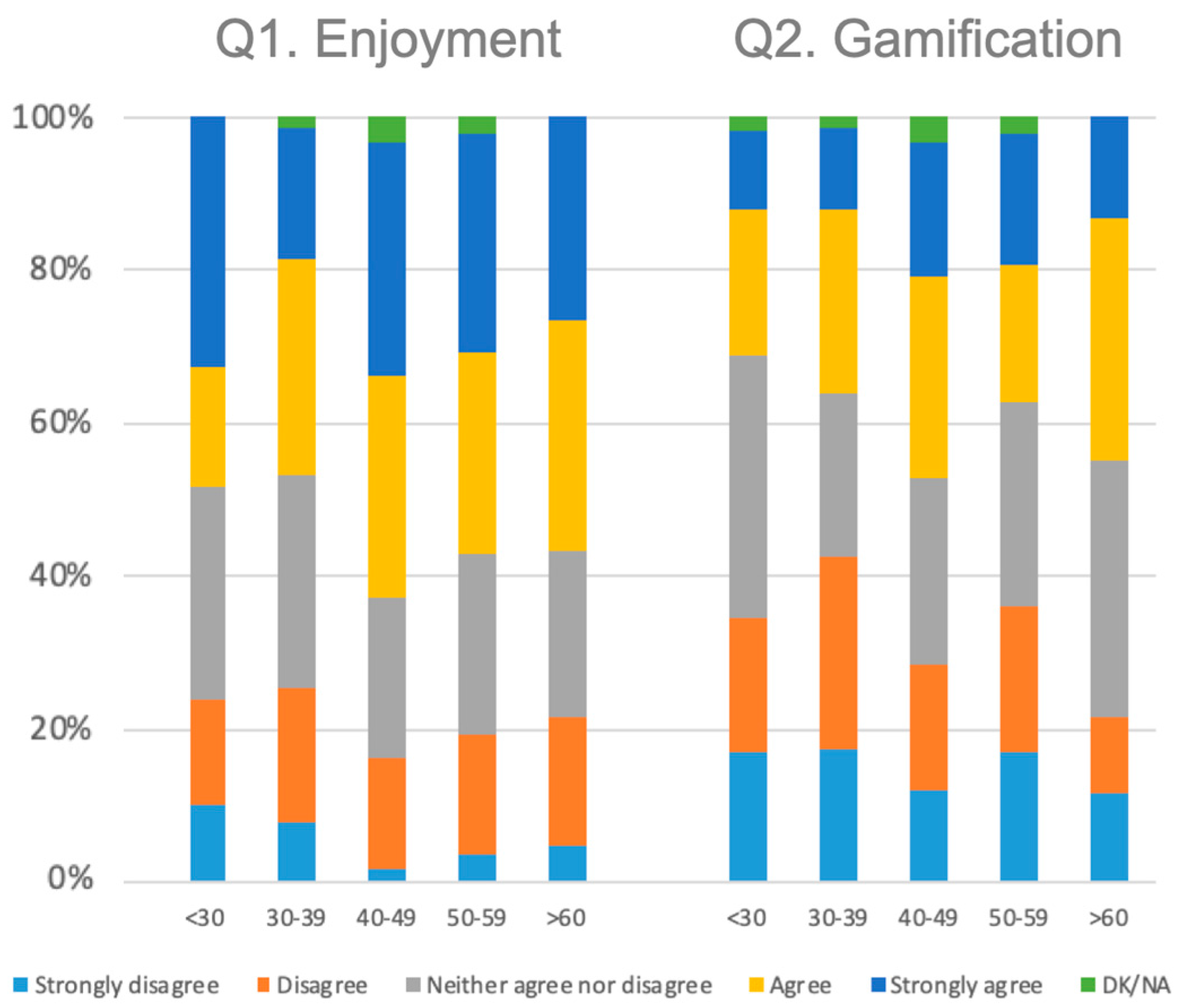

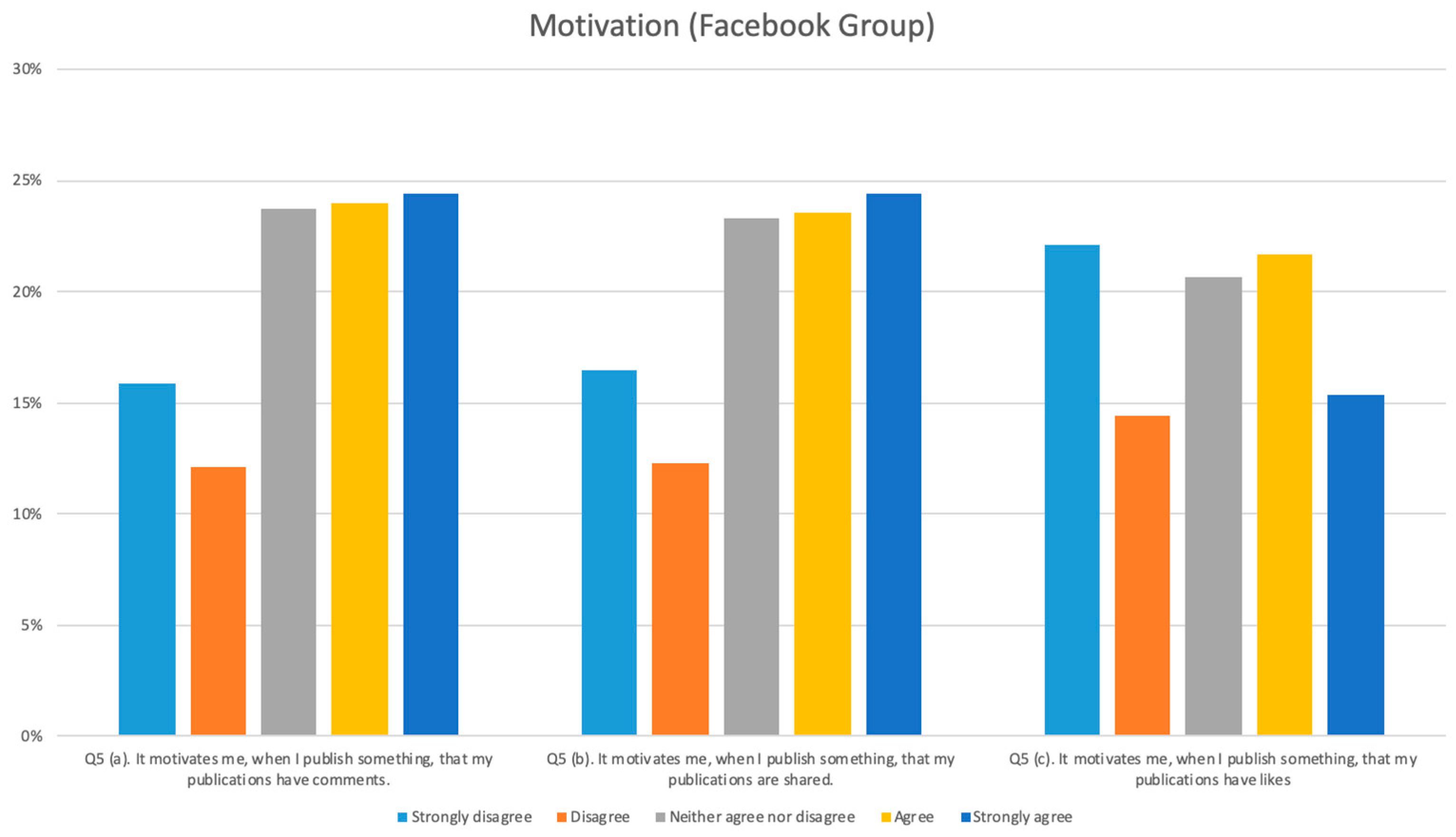
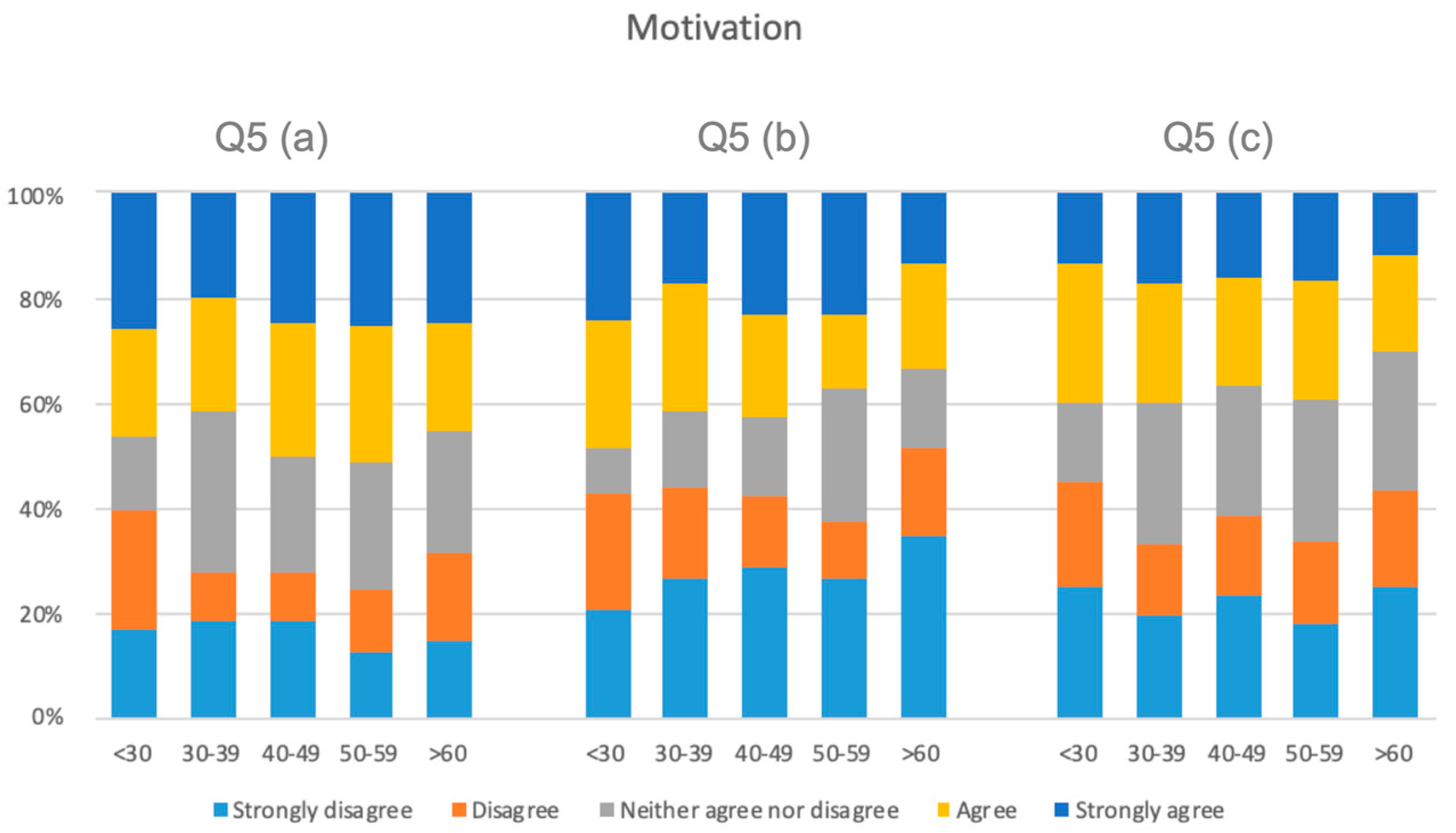
| Technologies | ||
|---|---|---|
| Asynchronous Activities | MiriadaX (MOOC platform) | |
| Synchronous Activities | Kahoot! | |
| Sli.do | ||
| Virtual Learning Communities | Facebook Group | Likes |
| Shares | ||
| Units | ||
| Badges | ||
| MOOC (MiriadaX) | ||||
| Enrolled | Started | Finished (100%) | % (Enrolled) | % (Started) |
| 8532 | 4552 | 1359 | 15.9% | 29.8% |
| Finished (75%) | % (Enrolled) | % (Started) | ||
| 1655 | 19.4% | 36.3% | ||
| VLC (Facebook Group) | ||||
| Members | Publications | Comments | Reactions | |
| 2540 | 1980 | 2746 | 13,333 | |
| Live Events (Synchronous Activities) | |||||
|---|---|---|---|---|---|
| Building Digital Identity | What about Us on Internet | Interview with... (1) | Interview with... (2) | ||
| YouTube | |||||
| Streaming duration (min:sec) | 32:25 | 26:05 | 33:01 | 27:41 | |
| Event day | Day | 04/09/2018 | 11/09/2018 | 18/09/2018 | 25/08/2018 |
| Views | 798 | 803 | 270 | 381 | |
| Peak concurrents | 182 | 157 | 83 | 78 | |
| Unique viewers | 599 | 534 | 214 | 319 | |
| Likes | 71 | 41 | 59 | 48 | |
| Shares | 19 | 8 | 6 | 7 | |
| Chat messages | 373 | - | - | - | |
| Until end of MOOC (25/09/2018) | Period | 22 days | 15 days | 7 days | 1 day |
| Views | 2834 | 1333 | 608 | 515 | |
| Unique viewers | 1963 | 886 | 444 | 412 | |
| Likes | 110 | 52 | 70 | 53 | |
| Shares | 83 | 12 | 14 | 8 | |
| After finishing MOOC 26/09/2018 to 01/04/2019 | Views | 3290 | 1407 | 672 | 664 |
| Likes | 112 | 55 | 70 | 57 | |
| Shares | 96 | 12 | 10 | 8 | |
| Comments | 46 | 32 | 5 | 3 | |
| Kahoot! | Participants | - | 88 | - | - |
| Sli.do | Participants | - | - | 49 | 41 |
| Questions | - | - | 50 | 36 | |
| Likes | - | - | 102 | 52 | |
| Q1. Enjoyment | I had fun with the MOOC |
| Q2. Gamification | I felt like I was in a game in the MOOC |
| Q3. Participation | I have shared in the Facebook community the proposed activities of the course |
| Q4. Participation (a, b, c, d e) | Participation in the Facebook group (a) reading, (b) publishing, (c) commenting to others, (d) likes and (e) sharing publications |
| Q5. Motivation (a, b, c) | It encourages me, when I publish something, that my publications: (a) have comments, (b) are shared and (c) have likes |
| Q6. Engagement | I have felt part of the community |
| Q7. Completion | I’ve passed the MOOC |
| Q1. I had Fun with the MOOC | ||||||
|---|---|---|---|---|---|---|
| Strongly Disagree | Disagree | Neither Agree nor Disagree | Agree | Strongly Agree | ||
| Q2. I felt like I was in a game in the MOOC | Strongly Disagree | 16.82% | 39.19% | 10.53% | 4.72% | 2.26% |
| Disagree | 20.56% | 47.30% | 30.70% | 9.45% | 1.50% | |
| Neither Agree nor Disagree | 25.23% | 12.16% | 50.88% | 36.22% | 12.03% | |
| Agree | 17.76% | 1.35% | 7.02% | 48.03% | 31.58% | |
| Strongly Agree | 18.69% | 0.00% | 0.88% | 1.57% | 50.38% | |
| Q6. I have felt part of the community | Strongly Disagree | 73.91% | 14.86% | 1.75% | 0.00% | 0.75% |
| Disagree | 26.09% | 44.59% | 21.05% | 5.51% | 1.50% | |
| Neither Agree nor Disagree | 0.00% | 37.84% | 56.14% | 23.62% | 1.50% | |
| Agree | 0.00% | 1.35% | 16.67% | 47.24% | 24.06% | |
| Strongly Agree | 0.00% | 1.35% | 4.39% | 22.05% | 67.67% | |
| Q3. I have shared in the Facebook community the proposed activities of the course | Strongly Disagree | 86.96% | 51.35% | 34.21% | 36.22% | 22.56% |
| Disagree | 8.70% | 21.62% | 22.81% | 23.62% | 14.29% | |
| Neither Agree nor Disagree | 0.00% | 17.57% | 24.56% | 21.26% | 22.56% | |
| Agree | 4.35% | 6.76% | 13.16% | 10.24% | 20.30% | |
| Strongly Agree | 0.00% | 2.70% | 5.26% | 8.66% | 20.30% | |
| Q4 (d). Participation in the Facebook group [Likes] | Strongly Disagree | 73.91% | 47.30% | 32.46% | 37.01% | 21.05% |
| Disagree | 13.04% | 22.97% | 21.05% | 19.69% | 12.03% | |
| Neither Agree nor Disagree | 4.35% | 16.22% | 16.67% | 9.45% | 4.51% | |
| Agree | 2.17% | 7.43% | 17.54% | 23.62% | 28.20% | |
| Strongly Agree | 6.52% | 6.08% | 12.28% | 10.24% | 34.21% | |
© 2019 by the authors. Licensee MDPI, Basel, Switzerland. This article is an open access article distributed under the terms and conditions of the Creative Commons Attribution (CC BY) license (http://creativecommons.org/licenses/by/4.0/).
Share and Cite
Borrás-Gené, O.; Martínez-Núñez, M.; Martín-Fernández, L. Enhancing Fun through Gamification to Improve Engagement in MOOC. Informatics 2019, 6, 28. https://doi.org/10.3390/informatics6030028
Borrás-Gené O, Martínez-Núñez M, Martín-Fernández L. Enhancing Fun through Gamification to Improve Engagement in MOOC. Informatics. 2019; 6(3):28. https://doi.org/10.3390/informatics6030028
Chicago/Turabian StyleBorrás-Gené, Oriol, Margarita Martínez-Núñez, and Luis Martín-Fernández. 2019. "Enhancing Fun through Gamification to Improve Engagement in MOOC" Informatics 6, no. 3: 28. https://doi.org/10.3390/informatics6030028
APA StyleBorrás-Gené, O., Martínez-Núñez, M., & Martín-Fernández, L. (2019). Enhancing Fun through Gamification to Improve Engagement in MOOC. Informatics, 6(3), 28. https://doi.org/10.3390/informatics6030028







